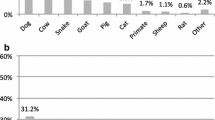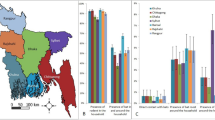Abstract
Due to the high level of biological diversity in the Congo Basin and human population dependence on bushmeat, the DRC represents an ideal location for expanding knowledge on wild animal exposures and thus the potential for transmission of zoonotic pathogens. However, limited information exists on patterns and extent of contact with wildlife in such communities. Using a cross-sectional study, 14 villages in the Sankuru Province of the DRC were surveyed between August and September 2007. Villagers ≥ 1 year of age and at home of the time of the survey were eligible and enrolled to describe and assess factors associated with animal exposures (both activity and type of animal). Among respondents, 91% reported exposure to rodents, 89% to duikers, 78% to non-human primates (NHPs), and 32% reported contact with bats in the month prior to the survey. The most frequently reported activities included eating (95%), cooking (70%), and butchering or skinning of animals (55%). The activities and animals to which subjects had contact varied by sex and age. Moreover, we observed a high correlation of the same activities across animal types. In this and other populations that rely on bushmeat, there is a high frequency of exposure to multiple animal species through various modalities. In the event of future zoonotic disease outbreaks, effective public health interventions and campaigns that mitigate the risk of animal contact during outbreaks need to be broad to include various modes of contact and should be directed to both men and women across all age groups. As available information is limited, further studies are necessary to better understand the complex relationships and exposures individuals have with animals.



Similar content being viewed by others
References
Aghokeng AF, Ayouba A, Mpoudi-Ngole E, Loul S, Liegeois F, Delaporte E, et al. Extensive survey on the prevalence and genetic diversity of SIVs in primate bushmeat provides insights into risks for potential new cross-species transmissions. Infection, Genetics and Evolution 2010;10(3):386-396
Calattini S, Chevalier SA, Duprez R, Bassot S, Froment A, Mahieux R, et al. Discovery of a new human T-cell lymphotropic virus HTLV-3 in Central Africa. Retrovirology 2005;9:30
Calvignac-Spencer S, Adjogoua EV, Akoua-Koffi C, Hedemann C, Schubert G, Ellerbrok H, et al. Origin of human T-lymphotropic virus type 1 in rural Cote d’Ivoire. Emerg Infect Dis 2012;18(5):830-3
Cole SR, Hernan MA. Constructing inverse probability censoring weight for marginal structural models. American Journal of Epidemiology 2008;168(6):656-664
Daszak P, Cunningham AA, Hyatt AD. Anthropogenic environmental change and the emergence of infectious diseases in wildlife. Acta Tropica 2001;78(2):103-116
Davies TJ, Pedersen AB. Phylogeny and geography predict pathogen community similarity in wild primates and humans. Proceedings of the Royal Society of London B: Biological Sciences 2008;275(1643):1695-1701
De Merode E, Homewood K, Cowlishaw G. The value of bushmeat and other wild foods to rural households living in extreme poverty in Democratic Republic of Congo. Biological conservation 2004;118(5):573-581
Dobson AP. What links bats to emerging infectious diseases? Science 2005;310(5748):628-629
Fa JE, Peres CA, Meeuwig J. Bushmeat exploitation in tropical forests: an intercontinental comparison. Conserv Biol 2002;16:232-237
FAO (2011) The State of Forests in the Amazon Basin, Congo Basin and Southeast Asia: A report prepared for the Summit of the Three Rainforest Basins, Brazzaville, Republic of Congo. Report. Brazzaville, Republic of Congo: Food and Agriculture Organization of the United Nation; 2011 31 May-3 June, 2011. Report No.: ISBN 978-92-5-106888-5
Friant S, Paige SB, Goldberg TL. Drivers of bushmeat hunting and perceptions of zoonoses in Nigerian hunting communities. PLOS Neglected Tropical Diseases 2015;9(5):e0003792
Gessain A, Rua R, Betsem E, Turpin J, Mahieux R. HTLV-3/4 and simian foamy retroviruses in humans: discovery, epidemiology, cross-species transmission and molecular virology. Virology 2013;435(1):187-199
Golden CD, Fernald LCH, Brashares JS, Rasolofoniaina BJR, Kremen C. Benefits of wildlife consumption to child nutrition in a biodiversity hotspot. Proceedings of the National Academy of Sciences of the United States of America 2011;108(49):19653-19656
Hayman DT, Bowen RA, Cryan PM, McCracken GF, O’Shea TJ, Peel AJ, et al. Ecology of zoonotic infectious diseases in bats: current knowledge and future directions. Zoonoses Public Health 2013;60(1):2-21
Hutson CL, Carroll DS, Gallardo-Romero N, Weiss S, Clemmons C, Hughes CM, et al. Monkeypox disease transmission in an experimental setting: prairie dog animal model. PLoS One 2011;6(12):e28295
Jezek Z, Arita I, Mutombo M, Dunn C, Nakano J, Szczeniowski M. Four generations of probable person-to-person transmission of human monkeypox. American journal of epidemiology 1986;123(6):1004-1012
Jezek Z, Nakano JH, Arita I, Mutombo M, Szczeniowski M, Dunn C. Serological survey for human monkeypox infections in a selected population in Zaire. J Trop Med Hyg 1987;90(1):31-8
Kalish ML, Wolfe ND, Ndongmo CB, McNicholl J, Robbins KE, Aidoo M, et al. Central African hunters exposed to simian immunodeficiency virus. Emerging Infectious Disease 2005;11:1928-1930
Karesh WB, Noble E. The bushmeat trade: increased opportunities for transmission of zoonotic disease. Mt Sinai J Med 2009;76:429-434
Khodakevich L, Szczeniowski M, Manbu ma D, Jezek Z, Marennikova S, Nakano J, et al. The role of squirrels in sustaining monkeypox virus transmission. Trop Geogr Med 1987;39(2):115-22
Khodakevich L, Szczeniowski M, Nambu ma D, Jezek Z, Marennikova S, Nakano J, et al. Monkeypox virus in relation to the ecological features surrounding human settlements in Bumba zone, Zaire. Trop Geogr Med 1987;39(1):56-63
Lahm SA, Kombila M, Swanepoel R, Barnes RF. Morbidity and mortality of wild animals in relation to outbreaks of Ebola haemorrhagic fever in Gabon, 1994-2003. Trans R Soc Trop Med Hyg 2007;101(1):64-78
Leroy EM, Epelboin A, Mondonge V, Pourrut X, Gonzalez J-P, Muyembe-Tamfum J-J, et al. Human Ebola outbreak resulting from direct exposure to fruit bats in Luebo, Democratic Republic of Congo, 2007. Vector-borne and zoonotic diseases 2009;9(6):723-728
Locatelli S, Peeters M. Cross-species transmission of simian retroviruses: how and why they could lead to the emergence of new diseases in the human population. AIDS 2012;26(6):659-73
Luis AD, Hayman DT, O’Shea TJ, Cryan PM, Gilbert AT, Pulliam JR, et al. A comparison of bats and rodents as reservoirs of zoonotic viruses: are bats special? Proc Biol Sci 2013;280(1756):20122753
Malleson R, Asha S, Sunderland T, Burnham P, Egot M, Obeng-Okrah K, et al. (2008) A methodology for assessing rural livelihood strategies in West/Central Africa: lessons from the field. Ecological and Environmental Anthropology
Meerburg BG, Singleton GR, Kijlstra A. Rodent-borne diseases and their risks for public health. Critical Reviews in Microbiology 2009;35(3):221-270
Milner-Gulland EJ, Bennett EL (2003) Wild meat: the bigger picture. Trends Ecol Evol 18:351–357
Ministry of Health DRoC (2009) Recensement, Bureau Central du Zone de Sante. In: Direction i, (editors), Kinshasa: Ministry of Health
Morens DM, Folkers GK, Fauci AS. The challenge of emerging and re-emerging infectious diseases. Nature 2004;430:242-249
Mossoun A, Pauly M, Akoua-Koffi C, Couacy-Hymann E, Leendertz SAJ, Anoh AE, et al. Contact to non-human primates and risk factors for zoonotic disease emergence in the Taï region, Côte d’Ivoire. EcoHealth 2015;12(4):580-591
Murphy FA. Emerging zoonoses. Emerging Infectious Diseases 1998;4:429-435
Observatory for the Forests of Central Africa (2010) Congo basin forest partnership. The forests of the Congo basin: state of the forest. In: Luxembourg: Publications Office of the European Union. p. v
Organization WH. Outbreak of Ebola haemorrhagic fever in Gabon officially declared over. Wkly Epidemiol Rec 1996;71(17):125-126
Paige SB, Frost SD, Gibson MA, Jones JH, Shankar A, Switzer WM, et al. Beyond bushmeat: animal contact, injury, and zoonotic disease risk in Western Uganda. EcoHealth 2014;11(4):534-543
Parker S, Nuara A, Buller RM, Schultz DA. Human monkeypox: an emerging zoonotic disease. Future Microbiol 2007;2(1):17-34
Peeters M, Courgnaud V, Abela B, Auzel P, Pourrut X, Bibollet-Ruche F, et al. (2002) Risk to human health from a plethora of simian immunodeficiency viruses in primate bushmeat. Emerg Infect Dis [serial on the Internet]
Poulsen J, Clark C, Mavah G, Elkan P. Bushmeat supply and consumption in a tropical logging concession in northern Congo. Conservation Biology 2009;23(6):1597-1608
Roess AA, Monroe BP, Kinzoni EA, Gallagher S, Ibata SR, al e. Assessing the effectiveness of a community intervention for monkeypox prevention in the Congo Basin. PLOS Neglected Tropical Diseases 2011;5(10):e1356
Switzer WM, Tang S, Ahuka-Mundeke S, Shankar A, Hanson DL, Zheng H, et al. Novel simian foamy virus infections from multiple monkey species in women from the Democratic Republic of Congo. Retrovirology 2012;9:100
Taylor LH, Latham SM, Woolhouse ME. Risk factors for human disease emergence. Philos Trans R Soc Lond B Biol Sci 2001;356(1411):983-9
United Nations (2014) Department of Economic and Social Affairs., United Nations. Statistical Division. World Statistics Pocketbook. New York: United Nations
Wolfe ND, Prosser TA, Carr JK, Tamoufe U, Mpoudi-Ngole E, Torimiro JN, et al. Exposure to nonhuman primates in rural Cameroon. Emerg Infect Dis 2004;10(12):2094-9
Wolfe ND, Switzer WM, Carr JK, Bhullar VB, Shanmugam V, Tamoufe U, et al. Naturally acquired simian retrovirus infections in central African hunters. The Lancet 2004;363(9413):932-937
Wolfe ND, Daszak P, Kilpatrick AM, Burke DS. Bushmeat hunting, deforestation, and prediction of zoonotic disease. Emerging Infectious Diseases 2005;11:1822-1827
Wolfe ND, Switzer WM, Carr JK, Bhullar VB, Shanmugam V, Tamoufe U, et al. Emergence of unique primate T-lymphotropic viruses among central African bushmeat hunters. Proc Natl Acad Sci 2005;102:7994-7999
Wolfe ND, Dunavan CP, Diamond J. Origins of major human infectious diseases. Nature 2007;447(7142):279-283
Acknowledgements
Many individuals contributed to the design of this manuscript and data collection in the field. We thank the health care workers in the Sankuru Province and the DRC Ministry of Health for their surveillance efforts and assistance with the implementation of this study. We also thank Cyrus Sinai for assisting with Fig. 1 (DRC map) and Haroutune Armenian for comments and suggestions on the manuscript.
Funding
This work was supported by: the Eunice Kennedy Shriver National Institute of Child Health and Human Development, Global Network for Women’s and Children’s Health Research; National Institute of Allergy and Infectious Diseases, Division of Infectious Diseases and Microbiology (5K01AI074810-05); Fogarty International Center, Research and Policy for Infectious Disease Dynamics (RAPIDD) program of the Science and Technology Directorate, Department of Homeland Security; and the Faucett Catalyst Fund.
Author information
Authors and Affiliations
Contributions
AWR designed the study, supervised all aspects of study implementation, collected the data, guided data analysis; VHA conducted data analysis, developed figures and tables; AWR and VHA wrote and edited the manuscript; NAH and RHD assisted with data cleaning and manuscript editing; PMM, NKK, EOW and JJM participated in study design and implementation; LLW participated in study design, implementation, and editing the manuscript.
Corresponding author
Ethics declarations
Conflict of interest
The authors report no conflict of interest with regard to this publication.
Additional information
Linda L. Wright—Retired from National Institute of Child Health and Human Development, National Institutes of Health.
Electronic supplementary material
Below is the link to the electronic supplementary material.
Rights and permissions
About this article
Cite this article
Rimoin, A.W., Alfonso, V.H., Hoff, N.A. et al. Human Exposure to Wild Animals in the Sankuru Province of the Democratic Republic of the Congo. EcoHealth 14, 552–563 (2017). https://doi.org/10.1007/s10393-017-1262-9
Received:
Revised:
Accepted:
Published:
Issue Date:
DOI: https://doi.org/10.1007/s10393-017-1262-9




